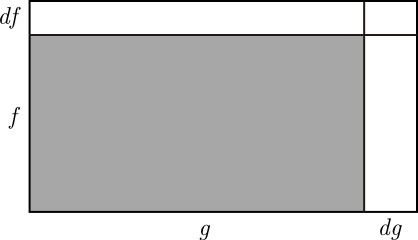另一种方法,我们可以从无穷小的量中获得一个定义明确的有限数,就是将一个这样的量除以另一个量。
我们将在整个过程中假设我们正在处理行为良好的函数,这意味着你可以绘制这样的函数的图形而不抬起你的铅笔,并且你也可以对函数的每个导数做同样的事情。那么什么是函数,什么是函数的导数呢?
一个函数  是一个带有输入和输出的机器。输入一个数字
是一个带有输入和输出的机器。输入一个数字  ,就会输出数字
,就会输出数字  有点令人困惑的是,我们有时将
有点令人困惑的是,我们有时将  不仅仅看作一个输出数字的机器,而是看作当插入
不仅仅看作一个输出数字的机器,而是看作当插入  时输出的数字。
时输出的数字。

(第一个)导数  的
的  是一个函数,它告诉我们
是一个函数,它告诉我们  在
在  增加时(从给定值开始
增加时(从给定值开始  比如
比如  ) 增加多少,在
) 增加多少,在  的增加量
的增加量  和
和  的对应增加量
的对应增加量  (当然可能为负)趋于 0
(当然可能为负)趋于 0

上面的图表说明了这个极限。比值  是穿过黑点的直线的斜率(即
是穿过黑点的直线的斜率(即  正
正  轴与直线之间的夹角,从正
轴与直线之间的夹角,从正  轴逆时针方向测量)。当
轴逆时针方向测量)。当  减小,位于
减小,位于  的黑点沿着
的黑点沿着  的图形滑向位于
的图形滑向位于  的黑点,而直线的斜率增大。在极限
的黑点,而直线的斜率增大。在极限  时,直线成为
时,直线成为  的切线,在
的切线,在  与其相切。
与其相切。  在
在  处的切线的斜率就是我们所说的
处的切线的斜率就是我们所说的  在
在 
所以,函数  的一阶导数
的一阶导数  是一个函数,它对于每个
是一个函数,它对于每个  都等于
都等于  的斜率。求导 一个函数
的斜率。求导 一个函数  就是求得它的 一阶导数
就是求得它的 一阶导数  对
对  求导,我们得到
求导,我们得到  的二阶导数
的二阶导数  ,对
,对  求导,我们得到三阶导数
求导,我们得到三阶导数  等等。
等等。
很容易证明,如果  是一个数字,并且
是一个数字,并且  和
和  是
是  的函数,则
的函数,则
 和
和 
一个稍微难一点的问题是,求两个关于  的函数的乘积
的函数的乘积  的导数。将
的导数。将  和
和  视为面积为
视为面积为  的矩形的垂直边和水平边。当
的矩形的垂直边和水平边。当  增加
增加  乘积
乘积  增加图中三个白色矩形的面积之和。
增加图中三个白色矩形的面积之和。

换句话说,

因此

如果我们现在取极限,其中 以及因此
以及因此  和
和  趋近于 0,则右手边的前两项趋近于
趋近于 0,则右手边的前两项趋近于  第三项怎么样?因为它是一个趋近于 0 的表达式(
第三项怎么样?因为它是一个趋近于 0 的表达式( 或
或  )与一个趋近于有限值的表达式(
)与一个趋近于有限值的表达式( 或
或  )的乘积,因此它趋近于 0。底线
)的乘积,因此它趋近于 0。底线

这很容易推广到  个函数的乘积。这是一个特例
个函数的乘积。这是一个特例

观察到,两个等号之间有  个相等的项。如果函数
个相等的项。如果函数  返回你插入的任何东西,这归结为
返回你插入的任何东西,这归结为

现在假设  是
是  的函数,而
的函数,而  是
是  的函数。当
的函数。当  增加
增加  时,
时, 增加
增加  这反过来会导致
这反过来会导致  增加
增加  因此
因此  在极限
在极限  时,
时, 变为
变为 

我们得到了  对于整数
对于整数  显然它也适用于
显然它也适用于  和
和 
- 证明它也适用于负整数
 提示:使用乘积法则计算
提示:使用乘积法则计算 
- 证明
 提示: 使用乘积法则计算
提示: 使用乘积法则计算 
- 证明
 也适用于
也适用于  其中
其中  是自然数。
是自然数。
- 证明当
 是有理数时,这个等式仍然成立。 使用
是有理数时,这个等式仍然成立。 使用 
由于每个实数都是有理数序列的极限,所以我们可以放心地假设  对所有实数
对所有实数 




























































